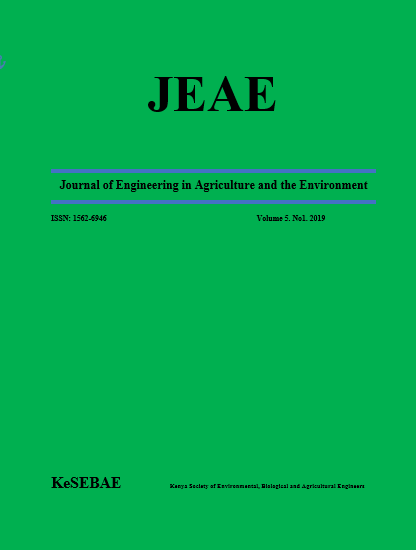Abstract
An automated solar dryer was designed, constructed and tested under no-load condition and load condition. The components of the dryer include an electromagnetic actuator jack, electronic positional controller, magnetic compass, solar collector and drying cabinet. The actuator jack is designed in such a way that the collector angle varies automatically as the sun rises and sets. In this manner, the drying products get maximum heat energy from the sun rays at any given time. This technology enables the product to be left inside the dryer without any need for manual turning of the collector along the direction of the sun rays. In operation, the actuator jack receives a signal from the electronic positional controller and the resulting inward and outward movement of the jack leads to an angular displacement of 15o for every hour of drying. The result of no load test showed that the average air temperature inside the dryer was 66oC given a rise of 22oC over the ambient condition in Ilorin (42oC) at the time of testing. 1kg of cassava chips was dried to a moisture content of 11.1% (wb) in 9 hours showing that the dryer has performed satisfactorily and is recommended for cassava chips drying
References
Alonge, A.F and Oje, K. 2006. Computer Modelling of optimum angle of slope for flat solar collectors in Nigeria major towns. Proceedings
of an International Conference organized by the American Society of Agricultural and Biological Engineers (ASABE) on “World Congress on Computers in Agriculture
(WCCA)” held at Orlando, Florida, USA
between July 22 and 24, 2006. Pages 352-357
Alonge, A.F and Oje, K. 2006. Determination of the optimum collector angle for composite solar dryers at Ilorin, Nigeria. Journal of Applied Science, Engineering and Technology (JASET) published by Faculty of Technology, University of Ibadan, Nigeria, 3, 42-46. http://www.ajol.info/index.php/jaset/article/vie w/38305
Alonge, A.F. and Hameed, R.O. 2007. A direct passive solar dryer for tropical crops. African Crop Science Conference Proceedings, Egypt. Vol. 8, 1643 - 1646.
Alonge, A. F. and Oniya O.O. 2011. An Indirect passive Solar Dryer for Drying. Advanced Materials Research, 367, 517-524. Online available since 2011/Oct/24 at www.scientific.net Trans Tech Publications,
Switzerland. doi:
4028/www.scientific.net/AMR.367.517.
Alonge, A.F. and Omoniwa, A.O. 2012. Design and Modification of a Direct Passive Solar dryer. Paper presented at the Canadian Society for Bio Engineering (CSBE), Orillia, Toronto, Canada. July 15 -18, 2012.
Basunia, M.A., and Abe, T. 2001. Design and construction of a simple three-shelf solar rough rice dryer. Agricultural Mechanization in Asia, Africa and Latin America, 32 (4), 54-59.
Eke, A.B. 2002. Optimization and performance evaluation of natural convection solar dryer for sliced tomato. Unpublished PhD thesis, Department of Agricultural Engineering, Ahmadu Bello University, Zaria, Nigeria.
El-Shiatry, M.A., Muller, J., and Muhlbauer, W. 1991. Drying foods and vegetables. Agricultural Mechanization in Asia, Africa and Latin America, 22 (4), 62-66.

This work is licensed under a Creative Commons Attribution 4.0 International License.
